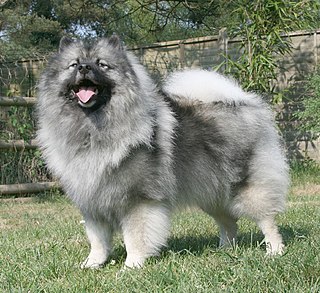
The Keeshond is a medium-sized dog with a plush, two-layer coat of silver and black fur with a ruff and a curled tail. Their closest relatives are the German spitzes such as the Großspitz, Mittelspitz, Kleinspitz, Zwergspitz (Dwarf-Spitz) or Pomeranian.
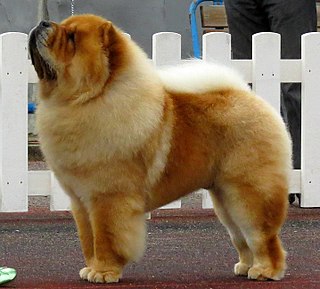
The Chow Chow is a spitz-type of dog breed originally from Northern China. The Chow Chow is a sturdily built dog, square in profile, with a broad skull and small, triangular, erect ears with rounded tips. The breed is known for a very dense double coat that is either smooth or rough. The fur is particularly thick in the neck area, giving it a distinctive ruff or mane appearance. The coat may be shaded/self-red, black, blue, cinnamon/fawn, or cream.

The Icelandic Sheepdog, is an Icelandic breed of dog of Nordic Spitz type. It derives from dogs brought to Iceland by Viking settlers in the ninth century; it is both similar and closely related to the Buhund of Norway and the Vallhund and Norrbottenpets of Sweden, which derive from the same ancestral stock.

The Samoyed is a breed of medium-sized herding dogs with thick, white, double-layer coats. They are spitz-type dogs which take their name from the Samoyedic peoples of Siberia. Descending from the Nenets Herding Laika, they are domesticated animals that assist in herding, hunting, protection and sled-pulling.

The American Eskimo Dog is a breed of companion dog, originating in Germany. The American Eskimo Dog is a member of the Spitz family. The breed's progenitors were German Spitz, but due to anti-German sentiment during the First World War, it was renamed "American Eskimo Dog." Although modern American Eskimo Dogs have been exported as German Spitz Gross, the breeds have diverged and the standards are significantly different. In addition to serving as a watchdog and companion, the American Eskimo Dog also achieved a high degree of popularity in the United States in the 1930s and 1940s as a circus performer.

The Vizsla, also known as Hungarian Vizsla, Magyar Vizsla or Hungarian Pointer, is a dog breed from Hungary and belongs to the Fédération Cynologique Internationale (FCI) group 7, the Canadian Kennel Club (CKC) group 1, and the American Kennel Club. The Hungarian or Magyar Vizsla or Smooth-Haired Vizsla are sporting dogs and loyal companions. The Vizsla's medium size is one of the breed's most appealing characteristics. As a hunter of fowl and upland game, the Vizsla has held a prominent position among sporting dogs – that of household companion and family dog.

The Poodle, called the Pudel in German and the Caniche in French, is a breed of water dog. The breed is divided into four varieties based on size, the Standard Poodle, Medium Poodle, Miniature Poodle and Toy Poodle, although the Medium Poodle is not universally recognised. They have a distinctive thick, curly coat that comes in many colors and patterns, with only solid colors recognized by breed registries. Poodles are active and intelligent, and are particularly able to learn from humans. Poodles tend to live 10–18 years, with smaller varieties tending to live longer than larger ones.

The Pembroke Welsh Corgi is a cattle herding dog breed that originated in Pembrokeshire, Wales. Around the 19th century, The Corgi used to be known as the Welsh Cur, Cur meaning working dog, and Gi being the Welsh word for "dog." It is one of two breeds known as a Welsh Corgi, the other being the Cardigan Welsh Corgi. Pembroke Welsh Corgis descended from the Spitz family of dog
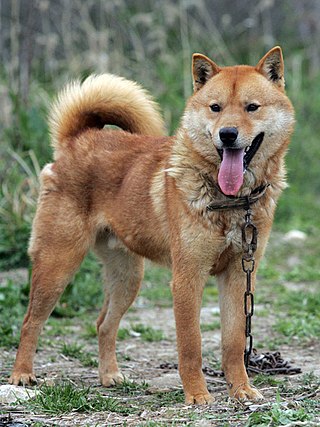
The Jindo dog is an indigenous dog native to the island of Jindo in South Korea. It is also known as Jindo-gyeon and formerly known as the Chindo dog.

The Finnish Spitz is a breed of dog originating in Finland. The breed was originally trained to hunt all types of game from squirrels and other rodents to bears. It is a "bark pointer", indicating the position of game by barking, and drawing the game animal's attention to itself, allowing an easier approach for the hunter. Its original game hunting purpose was to point to game that fled into trees, such as grouse, and capercaillies, but it also serves well for hunting elk. Some individuals have even been known to go after a bear. In its native country, the breed is still mostly used as a hunting dog. The breed is typically friendly and good with children, so it is suitable for domestic life. The Finnish Spitz has been the national dog of Finland since 1979.
Toy dog traditionally refers to a very small dog or a grouping of small and very small breeds of dog. A toy dog may be of any of various dog types. Types of dogs referred to as toy dogs may include spaniels, pinschers and terriers that have been bred down in size. Not all toy dogs are lap dogs.
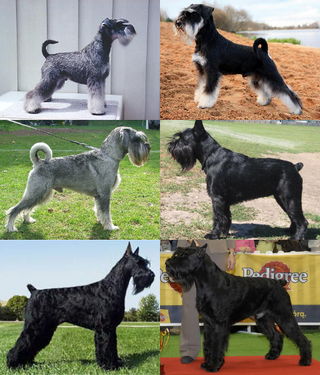
A Schnauzer is a dog breed type that originated in Germany from the 14th to 16th centuries. The term comes from the German word for "snout" and means colloquially "moustache", or "whiskered snout", because of the dog's distinctively bearded snout. Initially it was called Wire-Haired Pinscher, while Schnauzer was adopted in 1879.

The Shikoku Ken or Kōchi-ken (高知犬) is a Japanese breed of dog from Shikoku island. It was designated a living national monument of Japan in 1937 Tosa Inu. However, because this could lead to it being confused with the Tosa Fighting Dog, and the breed was also found in other prefectures, from around 1932 it was referred to as the Shikoku Ken.

The Norwegian Buhund is a breed of dog of the spitz type. It is closely related to the Icelandic Sheepdog and the Jämthund. The Buhund is used as a watch dog and an all purpose farm and herding dog.
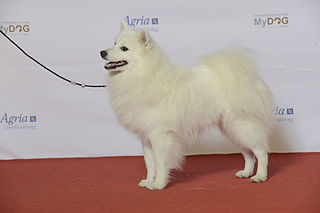
The Japanese Spitz is a small to medium breed of dog of the Spitz type. There are varying standards around the world as to the ideal size of the breed, but they are always larger than their smaller cousins, the Pomeranian. They were developed in Japan in the 1920s and 1930s by breeding a number of other Spitz type dog breeds together. They are recognized by the vast majority of the major kennel clubs, except the American Kennel Club due to it being of similar appearance to the white Pomeranian, American Eskimo Dog and Samoyed. While they are a relatively new breed, they are becoming widely popular due to their favorable temperament and other features.

The Eurasier, or Eurasian, is a spitz type breed of dog that originated in Germany through cross-breeding between popular European and Asian Spitz. It is widely known as a wonderful companion that maintains its own personality, has a dignified reserve with strangers, has a strong bond to its family, and is relatively easy to train.

The Finnish Lapphund is a hardy, easy going, medium-size breed of Spitz type. Traditionally it has been used for herding reindeer. Although it is one of the most popular dog breeds in its native country, Finland, it is not very numerous outside of the Nordic countries.

The Norrbottenspets, also known as the Norrbottenspitz, the Nordic Spitz and the Pohjanpystykorva, is a breed of spitz type dog from Sweden. A small- to medium-sized breed with typical spitz-like features, the Norrbottenspets has traditionally been kept as a hunting dog in Northern Sweden and is closely related to similar Nordic spitz breeds such as the Finnish Spitz.

Danish–Swedish Farmdog, historically known as the Danish Pinscher, is a breed of dog that has its origin in Denmark and southern Sweden, but has become popular all over Scandinavia, serving as a multi-purpose dog breed.

The Dalmatian is a breed of dog with a white coat marked with dark-coloured spots. Originally bred as a hunting dog, it was also used as a carriage dog in its early days. The origins of this breed can be traced back to Croatia and its historical region of Dalmatia. It is thought that early ancestors of the breed were certain breeds of pointers and a spotted Great Dane. Today, it is a popular pet and many enthusiasts enter Dalmatians into kennel club competitions.

























